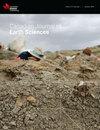努纳武特布西亚半岛沙那嘎湖剪切带的变形史及其构造意义
IF 1.6
4区 地球科学
Q3 GEOSCIENCES, MULTIDISCIPLINARY
引用次数: 0
摘要
最近发现的Sanagak湖剪切带(SLsz)是一条165公里长、西南突出的高应变岩石走廊,横跨努纳武特地区的布西亚半岛南部。该区域记录了~0.52 GPa和~700℃条件下的普遍变形(DSL1),以及≥0.5 GPa和300-500℃条件下的局部变形(DSL2),分别保持了左右侧向运动感觉。DSL1钛矿在含角闪石花岗闪长岩中新晶化,产矿年龄为1804±6 Ma,解释为DSL1的时代。DSL2的时间大致为40Ar/39Ar角闪石(1814±3 Ma)和黑云母(1743±1 Ma)冷却年龄,因为变形温度介于这两种矿物的估计闭合温度之间。剪切带两侧相似的岩石类型和变质条件排除了SLsz作为地体边界的可能性。相反,应变局部化可能是由1840 - 1820 Ma期间剪切带以南的东北向高温花岗岩带侵位引起的热软化引起的。布西亚半岛以南约1.81 Ga和Rae(委员会湾带)中部的变形变质作用归因于苏必利尔省与Rae克拉通东南边缘的碰撞,因此SLsz也可能是对这次碰撞产生的远场应力的响应。剪切带北部约1.81 Ga构造组构的缺失,表明该SLsz标志着中地壳的西北范围,与跨哈德逊有关的构造变质作用。本文章由计算机程序翻译,如有差异,请以英文原文为准。
Deformation history and tectonic significance of the Sanagak Lake shear zone, Boothia Peninsula, Nunavut
The recently recognized Sanagak Lake shear zone (SLsz) is a 165 km long, southwest striking corridor of high-strain rocks that transects the southern portion of Boothia Peninsula, Nunavut. This zone records pervasive deformation (DSL1) at conditions of ~0.52 GPa and ~700°C, and localized deformation (DSL2) at ≥ 0.5 GPa and 300-500°C that preserve left lateral and right lateral senses of movement, respectively. Neocrystallized DSL1 titanite in a hornblende-bearing granodiorite yield an age of 1804 ± 6 Ma, interpreted to be the timing of DSL1. The timing of DSL2 is loosely bracketed by 40Ar/39Ar hornblende (1814 ± 3 Ma) and biotite (1743 ± 1 Ma) cooling ages since the deformation temperature falls between the estimated closure temperature of these minerals. Similar rock types and metamorphic conditions on either side of the shear zone rule out the SLsz as a terrane boundary. Rather, strain localization may have been triggered by thermal softening related to the emplacement of a northeast-trending belt of high-temperature granites south of the shear zone between 1840 and 1820 Ma. Deformation and metamorphism at ca. 1.81 Ga south of Boothia Peninsula and in the central Rae (Committee Bay belt) has been attributed to the Superior Province colliding with the southeastern margin of the Rae craton, such that the SLsz may too have formed in response to far-field stresses derived from this collision. The absence of ca. 1.81 Ga tectonic fabrics north of the shear zone, indicates that the SLsz marks the northwestern extent of mid-crustal, Trans-Hudson related tectonometamorphism.
求助全文
通过发布文献求助,成功后即可免费获取论文全文。
去求助
来源期刊

Canadian Journal of Earth Sciences
地学-地球科学综合
CiteScore
2.80
自引率
7.10%
发文量
66
审稿时长
6-12 weeks
期刊介绍:
The Canadian Journal of Earth Sciences reports current research in climate and environmental geoscience; geoarchaeology and forensic geoscience; geochronology and geochemistry; geophysics; GIS and geomatics; hydrology; mineralogy and petrology; mining and engineering geology; ore deposits and economic geology; paleontology, petroleum geology and basin analysis; physical geography and Quaternary geoscience; planetary geoscience; sedimentology and stratigraphy; soil sciences; and structural geology and tectonics. It also publishes special issues that focus on information and studies about a particular segment of earth sciences.
 求助内容:
求助内容: 应助结果提醒方式:
应助结果提醒方式:


